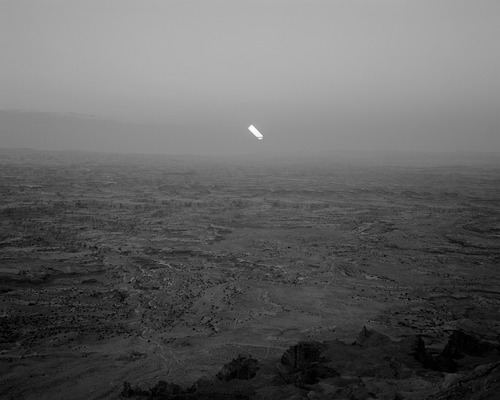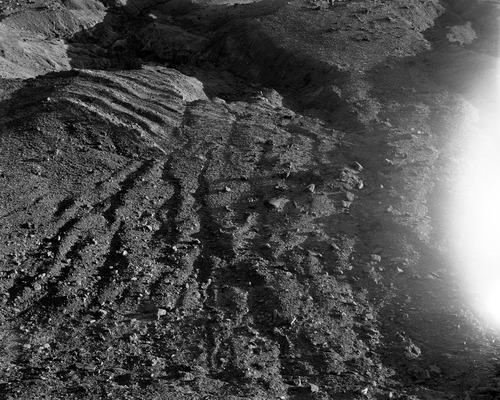
River Valley—from Transfigurations (32”x40” Gelatin Silver Print)
Bucky Miller in Conversation with Photographer Michael Lundgren
In Michael Lundgren’s kitchen there is something called the cabinet of death. It houses mostly artifacts that the photographer collects in the deserts of the Southwestern United States and Northern Mexico, but among the expected seed pods, mammal skulls, and dried-out lizards are some dusty, mysterious bits of technological evidence. The most memorable of these is a half-melted and charred orange pill bottle that has fused to the digital camera memory card it contained, creating a reliquary for something unknowable but entirely relatable.
The cabinet is a reasonable parallel to Lundgren’s picture-making. His first book, Transfigurations (Radius, 2008) was akin to a Sonoran landscape survey performed by a magical realist. The work he’s made since, which he calls Matter, is a bit different. The landscape has remained the same, but Mike’s relationship to it has evolved. A selection of those pictures are on view at Fraenkel Gallery in San Francisco as part of the exhibition Where There’s Smoke from July 10—August 23. On a recent and unexpected drive through the Arizona desert Mike and I started talking about the shift in his picture making and I started recording.
—Bucky Miller

Untitled—from Transfigurations (20” x 24” Gelatin Silver Print)
I. LOOK AT IT
THE BELIEVER: Your first book really was entrenched in the history of landscape photography, and I think the new work is less tied to the generation of photographers who influenced you. It deals with landscape in a way we aren’t used to seeing.
MICHAEL LUNDGREN: Exactly. The older work, I’ve been noticing more and more now looking at it, was really my way of digesting history, tracing the path of history in terms of photography in general, and specifically landscape photography. It charts the path of my understanding of my predecessors. It’s much less mine, even though I had thought it was mine at the time.
The new work has much less precedent, and the precedent is not in landscape photography. Even though it’s connected to the landscape, the precedent is in work that’s maybe only become possible because of the pictures generation.
BLVR: Like what?
ML: The idea that photographs come from other places. The idea that a valid art photograph does not just come from the solo artist with a vision, but that one can glean things from contemporary culture, from the vernacular, from advertising. That generation changed the way we see pictures. Larry Sultan and Mike Mandel are probably the largest, most obvious influence.
BLVR: Evidence.
ML:...
You have reached your article limit
Sign up for a digital subscription and continue reading all new issues, plus our entire archives, for just $1.50/month.
Already a subscriber? Sign in




